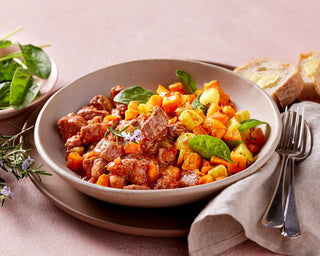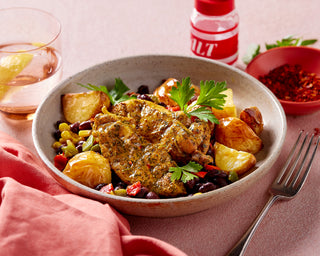
We all know we’re supposed to be getting ‘2&5-a-day’ of fruit and veg but what on earth is 1 serve? Do frozen veggies count? Do chips count? Surely our green juice counts right?
Let’s go back to the root of the numbers, they weren’t pulled out of thin air of course. They were actually based off of the World Health Organisation’s internationally recognised standard serving size of 400g of fruit and vegetables per person per day (not including potatoes and starchy tubers). Now unless you’re a real savvy cook or carry a measuring cup around with you 400g is hard to know straight off the bat. To make the message clearer, campaigners and marketers came up with the model of ‘2’ and ‘5’ which roughly equated to these recommendations and simple enough that you could count them on one hand.
Despite the clear message however, the last Australian Health Survey conducted in 2011-13 indicated that on average we consume 2.7 serves of vegetables and legumes/beans per day, leaving less than 4% of Aussies consuming the minimum amount of fruit & veggies and legumes/beans of 2 and 5 servings.
For the 96% Australians that aren’t getting their minimum number of servings, we’re here to help. Here’s our handy guide of what counts as one serve and how to get ‘2’ and ‘5’ serves of fruit and vegetables per day, trust us when we say it’s not as hard as you think.
What counts as a serve?
Fruit
Fruits are packed with essential nutrients such as fibre, vitamins, minerals, phytochemicals and water with endless evidence indicating their role in preventing chronic diseases.
Determined by the Australian Dietary Guidelines, one serving of fruit is roughly 150g or 350kJ or in other words:
|
Fresh Fruit |
|
|
1 |
Apple |
|
1 |
Orange |
|
1 |
Banana |
|
1 |
Pear |
|
1 |
Nectarine |
|
1 large |
Mandarin |
|
1 large or 2 small |
Kiwis |
|
2 |
Apricots |
|
½ cup |
Fruit Salad |
|
½ cup |
Grapes |
|
1 |
Pear |
|
½ cup |
Berries |
|
Dried Fruit |
|
|
1 ½ Tablespoons |
Sultanas, currants, dried cranberries or raisins |
|
2 |
Figs |
|
2 |
Prunes |
|
4 |
Apricot Halves |
|
Canned Fruit |
|
|
2 |
Pear Halves |
|
2 |
Peach Halves |
|
2 |
Pineapple Rings |
|
4 |
Apricot Halves |
|
10 |
Pineapple Chunks |
Source: check out our sources here and here
Half a cup of pure fruit juice with no added sugar is also considered one serve however best advice is to include these options occasionally as juices are relatively low in fibre and do not substitute for whole fruits. Canned varieties are also best with no added sugars or syrup in them.
Vegetables
Vegetables are nutrient power houses, but we don’t need to tell you that. They are rich in vitamins, fibre, potassium, minerals, antioxidants and phytochemicals with clear scientific evidence in its role in also preventing chronic diseases.
One serving of vegetables is roughly 75g or 100 – 350kJ:
|
Vegetables |
|
|
½ cup |
Cooked Green or Orange Vegetables |
|
½ cup |
Canned or dried beans, peas or lentils (including tomato – canned) |
|
1 cup |
Green leafy or raw vegetable salads |
|
½ cup |
Sweet Corn |
|
½ medium |
Potato or Starchy Vegetable (e.g. tubers, roots) |
|
1 medium |
Tomato or ~ 7 cherry tomatoes |
|
1 medium |
Onion or other bulb vegetables |
Source: https://www.eatforhealth.gov.au/food-essentials/how-much-do-we-need-each-day/serve-sizes
Yes, chips are technically potatoes however starchy vegetables are also served as carbohydrates or in this case as part of the ‘discretionary’ food group. Frozen vegetables on the other hand are absolutely considered a great source of vegetables and offer other nutritional benefits as well. To find out more on frozen veggies read this post here.
Handy Tips to get your “2 and 5”
It may seem impossible at first, but it’s completely achievable. By following these tricks you’ll be upping your number of serves in no time.
- Aim to add veggies in every meal especially breakfast, if you don’t have enough time in the morning meal planning and prepping works a treat (try veggie loaded frittatas or savoury veggie oatmeal, you may be surprised at how tasty it can be).
- Fill your plate so that at least half is veggies.
- Don’t be afraid to mix fresh, frozen & canned sources of veggies into your meal
- Make your smoothies with a “2:1” vegetable to fruit ratio.
- Variety is key so eat the rainbow with fruits and veggies
Meal Plan for a day:
Who likes meal planning? We do! (Check out our past post here). Need some help? Here’s a meal plan we made up earlier that will make sure you* get the right number of serves a day.
Breakfast
Bircher muesli with berries
Coffee with Milk
Fruit: 0.5 serve | Grains: 2 serves | Dairy: 0.25 serves
Morning Tea
Muesli Slice
Banana smoothie - Add 250ml Soy Milk & 1 Tablespoon Yoghurt & Chia Seeds
Fruit: 1 serve | Grains: 0.5 serves | Dairy: 1 serve
Lunch
Rustic Tomato and Ancient Grain Soup -
Add 2 slices x wholemeal crusty bread with melted cheese.
Vegetable: 2.5 serves | Grain: 2 serves | Dairy: 1 serve
Afternoon Snack
Apple
2 x Vita Wheat w/ Heirloom tomatoes, feta and basil
Fruit: 1 serve | Grain: 0.5 serves | Dairy: 0.5 serves
Dinner
Chicken Burrito Bowl
250g Chicken Burrito Mix
Topped with:
1/2 cup of canned black beans
1/4 Avocado (or more!)
Tomato Salsa or Pico de Gallo
1 Cup Green Leafy salad
Sour Cream/Yoghurt
1/2 Cup of Cooked Quinoa
Vegetables: 6 serves | Lean Protein: 2.3 serves | Grains: 1 serve | Dairy: 0.25 serves
Evening Snack
Cocoa Brownie Power Balls
Discretionary: 1 serve
*Recommendations are based off adult women between 19 – 50 years of age. Recommended servings vary according to age, sex and level of physical activity.
Not only are fruit and vegetables nutrient dense, they’re a simple way to improve your health in the long term. Through planning, creativity and awareness getting in those serves can be simple.










